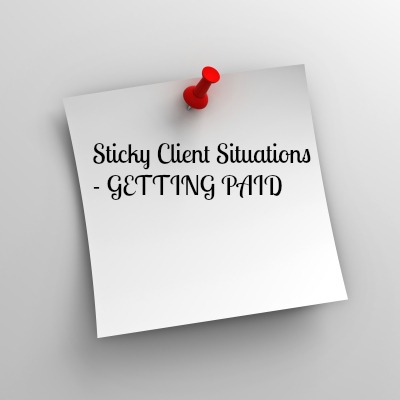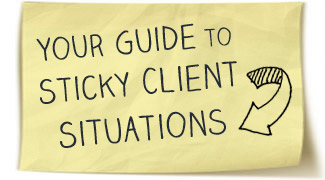
I recently received a very unhappy email from one of my readers. After contracting with a client on the job board ODesk and completing the job, she was now having a very difficult time receiving payment for her work.
Now, I advocate finding your own clients rather than working through third parties when possible for a variety of reasons. But I thought one of the main upsides of these sites was
that payment disputes are rare because of the third-party payment infrastructure.
Unfortunately, today’s job posters often have the option to pay “off-site,” which means, essentially, that once you complete the job, the job site is no longer able to provide you any
assistance.
Then you’ve got a common freelance fear on your hands:
What do you do when clients don’t pay?
Find Out Why the Client Isn’t Paying to Determine Your Approach
When you find yourself feeling like payment is late or that the client is being unresponsive to your invoices or reminders, the first thing to do is go back to your initial discussions.
More often than not, your emails are going unanswered, because the client doesn’t know what to tell you.
Clients typically don’t pay when you want them to for one of three reasons:
- They don’t think your work is done.
- They are having cash flow problems.
- They’re problem clients.
Can you find a clue to one of these situations in your initial communications?
Perhaps the client was very vague about revisions or their timeline. They probably haven’t paid you because they think more is needed on the project or some higher-up hasn’t yet
signed off on the project.
A phone call or email cc-ing all parties involved usually uncovers this situation, but if the client wants work past what you originally agreed upon, make it clear that you will require a
separate and additional payment for the extra work.
Or perhaps they are a start-up and have alluded to looking for funding or pausing the project until funding comes in.
They are probably having cash flow issues.
In this case, let them know that now that your work is done, payment must be furnished, but if they need to work out a payment plan or pay in the future, they need to discuss the dates with you now.
The only time you really need to bring in the big guns and threatening measures is when the client is a bad seed that has demonstrated that they aren’t planning on paying you, or that they’re only doing so when they feel like it regardless of your insistence.
Your Most Powerful Tool for Getting Payments On-Time
When a payment issue comes up, it seems like your ability to handle the situation tactfully—whether with some script or just by getting up the courage to pick up the phone or go over your client’s head to their accounting department—is the key to getting paid.
But the best way to get paid for your work is to make sure you have clear terms at the outset.
Even if you for some reason don’t sign a contract with your client (which you always should) payment terms should be part of your initial discussion.
When you negotiate the work to be provided, payment sum, and payment terms by phone or in person, always get it in writing, even if you just email a summary of your discussion to a client.
Having something—anything—in writing, even if you cobble it together by going back through strings of emails and noting who said what when, is what gives you fuel to force payment out of clients who are delaying for any number of reasons.
It works because, quite simply, paying you is easier than the alternative.
The threat of small claims court is far more useful than actually going to court. Small business payment disputes rarely go to court, as the more than $15 million dollars
owed in The World’s Longest Invoice demonstrates.
But even just bringing up the terms—and the fact that they are in writing—to a non-paying client can make all the difference in the
world.
For example, one freelancer I know had a long-standing client vanish during a holiday period and let three invoices go increasingly unpaid. Even though the client was in another country and legal action would have been far more expensive than it was worth, bringing up the contract terms
made all the difference.
Once she said, in writing, that the client was in breech of contract and she would withhold further (daily delivery) work until the invoices were resolved, the money appeared.
Immediately.
Your Second Best Resource For Getting Paid: Yourself
Don’t feel awkward about talking about money, when you get it, and how you get it…..
Period.
Always remember that you are providing your client with something that they need at a price they have agreed to. When you’re self-employed, all of your work is inherently transactional.
Some of us find that very real and comforting. You do something, and it has an immediate value to someone. But when you’re starting out and aren’t 100% confident in the value you’re providing, that can be seriously scary. It’s even tempting to discount or low-ball yourself to get a deal.
That’s the attitude that leads to reluctance to get payment terms clear and in writing and follow up when payment is due.
Even worse, you may get too invested in wanting more work from this client (even though they portend more headaches in the future since you’re having trouble getting payment from them now) because you are worried you won’t be able to find better work from better clients.
But the truth is, that whether you are worried about angering the client and endangering future assignments from them or just worried that somehow you’ll get a reputation as a difficult or annoying contractor, the results of being clear and assertive regarding payment are exactly the opposite.
By projecting confidence in your worth, clients are more likely to pay you promptly. Especially when you want clients to pay up front or immediately on delivery.
If you want to show you are really serious about getting paid—and going after slow payers—include a late fee penalty in your contracts. If payment is received 1-5 days after the due
date, 5% is added to the required sum. And it goes up from there.
FreshBooks, a web-based invoicing software that allows you to skip Paypal’s hefty payment fees, even tacks on late fees automatically, so your follow-up fears can’t get in the way!
Have you had a client non-payment issue that was quickly resolved? Or difficult to handle?
What has your experience been?
WANT MORE?





